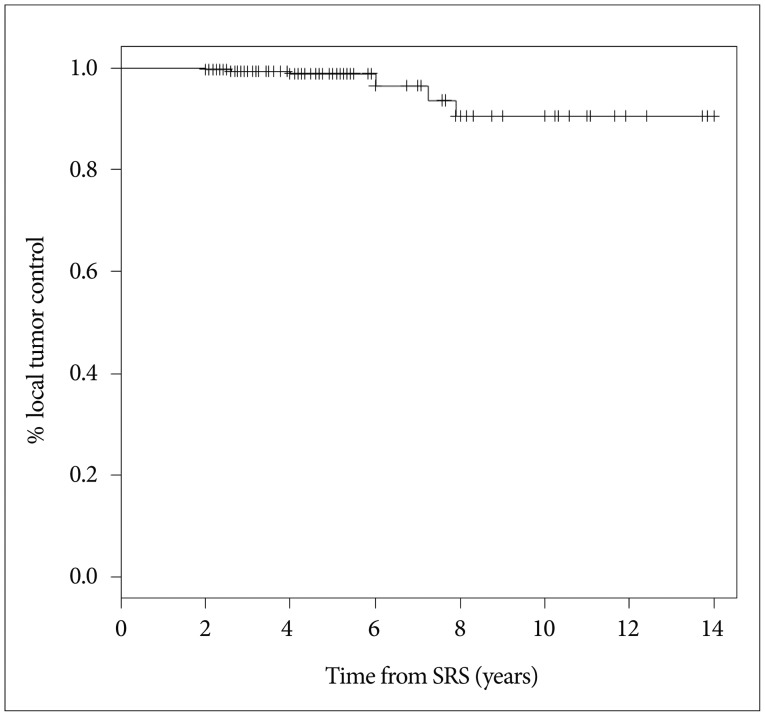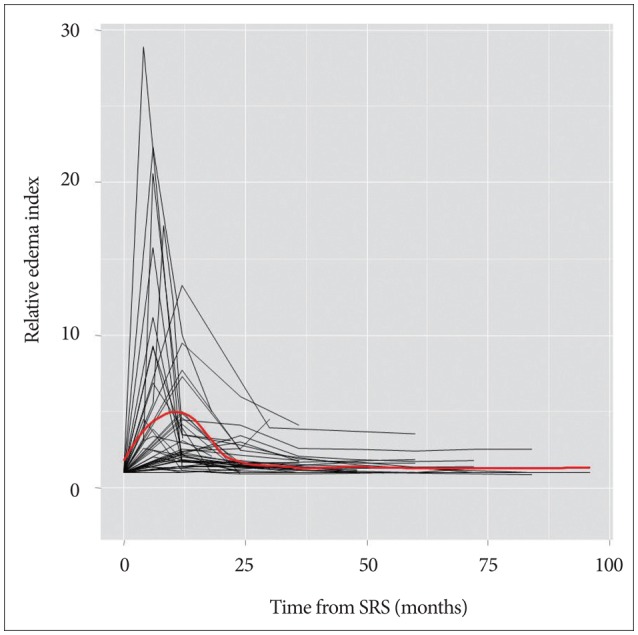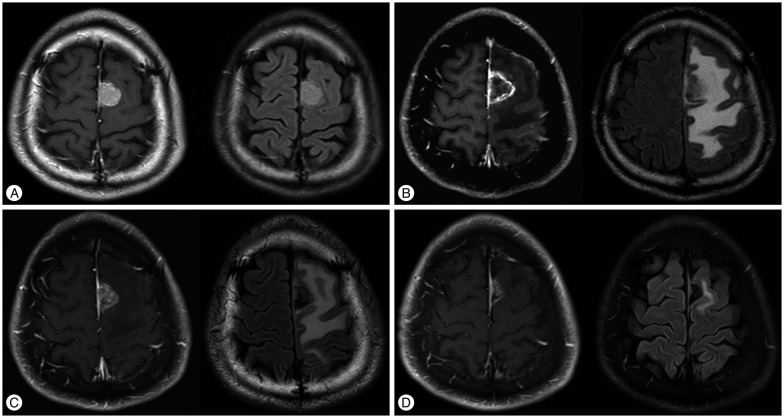J Korean Neurosurg Soc.
2015 Oct;58(4):379-384. 10.3340/jkns.2015.58.4.379.
Peritumoral Brain Edema after Stereotactic Radiosurgery for Asymptomatic Intracranial Meningiomas: Risks and Pattern of Evolution
- Affiliations
-
- 1Department of Neurosurgery, Asan Medical Center, University of Ulsan College of Medicine, Seoul, Korea. yhyunc@amc.seoul.kr
- 2Department of Neurosurgery, University of Ulsan College of Medicine, Seoul, Korea.
- KMID: 2114377
- DOI: http://doi.org/10.3340/jkns.2015.58.4.379
Abstract
OBJECTIVE
To investigate the risks and pattern of evolution of peritumoral brain edema (PTE) after stereotactic radiosurgery (SRS) for asymptomatic intracranial meningiomas.
METHODS
A retrospective study was conducted on 320 patients (median age 56 years, range 24-87 years) who underwent primary Gamma Knife radiosurgery for asymptomatic meningiomas between 1998 and 2012. The median tumor volume was 2.7 cc (range 0.2-10.5 cc) and the median follow-up was 48 months (range 24-168 months). Volumetric data sets for tumors and PTE on serial MRIs were analyzed. The edema index (EI) was defined as the ratio of the volume of PTE including tumor to the tumor volume, and the relative edema indices (rEIs) were calculated from serial EIs normalized against the baseline EI. Risk factors for PTE were analyzed using logistic regression.
RESULTS
Newly developed or increased PTE was noted in 49 patients (15.3%), among whom it was symptomatic in 28 patients (8.8%). Tumor volume larger than 4.2 cc (p<0.001), hemispheric tumor location (p=0.005), and pre-treatment PTE (p<0.001) were associated with an increased risk of PTE. rEI reached its maximum value at 11 months after SRS and decreased thereafter, and symptoms resolved within 24 months in most patients (85.7%).
CONCLUSION
Caution should be exercised in decision-making on SRS for asymptomatic meningiomas of large volume (>4.2 cc), of hemispheric location, or with pre-treatment PTE. PTE usually develops within months, reaches its maximum degree until a year, and resolves within 2 years after SRS.
Keyword
MeSH Terms
Figure
Reference
-
1. Bitzer M, Klose U, Geist-Barth B, Nägele T, Schick F, Morgalla M, et al. Alterations in diffusion and perfusion in the pathogenesis of peritumoral brain edema in meningiomas. Eur Radiol. 2002; 12:2062–2076. PMID: 12136325.
Article2. Cai R, Barnett GH, Novak E, Chao ST, Suh JH. Principal risk of peritumoral edema after stereotactic radiosurgery for intracranial meningioma is tumor-brain contact interface area. Neurosurgery. 2010; 66:513–522. PMID: 20173546.
Article3. Chang JH, Chang JW, Choi JY, Park YG, Chung SS. Complications after gamma knife radiosurgery for benign meningiomas. J Neurol Neurosurg Psychiatry. 2003; 74:226–230. PMID: 12531956.
Article4. Chang SD, Adler JR Jr. Treatment of cranial base meningiomas with linear accelerator radiosurgery. Neurosurgery. 1997; 41:1019–1025. discussion 1025-1027PMID: 9361055.
Article5. Gilbert JJ, Paulseth JE, Coates RK, Malott D. Cerebral edema associated with meningiomas. Neurosurgery. 1983; 12:599–605. PMID: 6877541.
Article6. Girvigian MR, Chen JC, Rahimian J, Miller MJ, Tome M. Comparison of early complications for patients with convexity and parasagittal meningiomas treated with either stereotactic radiosurgery or fractionated stereotactic radiotherapy. Neurosurgery. 2008; 62(5 Suppl):A19–A27. discussion A27-A28PMID: 18580776.
Article7. Hasegawa T, Kida Y, Yoshimoto M, Iizuka H, Ishii D, Yoshida K. Gamma Knife surgery for convexity, parasagittal, and falcine meningiomas. J Neurosurg. 2011; 114:1392–1398. PMID: 21128736.
Article8. Hashiba T, Hashimoto N, Izumoto S, Suzuki T, Kagawa N, Maruno M, et al. Serial volumetric assessment of the natural history and growth pattern of incidentally discovered meningiomas. J Neurosurg. 2009; 110:675–684. PMID: 19061353.
Article9. Jung KW, Ha J, Lee SH, Won YJ, Yoo H. An updated nationwide epidemiology of primary brain tumors in Republic of Korea. Brain Tumor Res Treat. 2013; 1:16–23. PMID: 24904884.
Article10. Kan P, Liu JK, Wendland MM, Shrieve D, Jensen RL. Peritumoral edema after stereotactic radiosurgery for intracranial meningiomas and molecular factors that predict its development. J Neurooncol. 2007; 83:33–38. PMID: 17245625.
Article11. Kim DG, Kim CH, Chung HT, Paek SH, Jeong SS, Han DH, et al. Gamma knife surgery of superficially located meningioma. J Neurosurg. 2005; 102(Suppl):255–258. PMID: 15662820.
Article12. Kollová A, Liscák R, Novotný J Jr, Vladyka V, Simonová G, Janousková L. Gamma Knife surgery for benign meningioma. J Neurosurg. 2007; 107:325–336. PMID: 17695387.
Article13. Kondziolka D, Mathieu D, Lunsford LD, Martin JJ, Madhok R, Niranjan A, et al. Radiosurgery as definitive management of intracranial meningiomas. Neurosurgery. 2008; 62:53–58. discussion 58-60PMID: 18300891.
Article14. Kuhn EN, Taksler GB, Dayton O, Loganathan A, Bourland D, Tatter SB, et al. Is there a tumor volume threshold for postradiosurgical symptoms? A single-institution analysis. Neurosurgery. 2014; 75:536–545. discussion 544-545quiz 545PMID: 25171304.
Article15. Kuratsu J, Kochi M, Ushio Y. Incidence and clinical features of asymptomatic meningiomas. J Neurosurg. 2000; 92:766–770. PMID: 10794289.
Article16. Lee CH, Jung KW, Yoo H, Park S, Lee SH. Epidemiology of primary brain and central nervous system tumors in Korea. J Korean Neurosurg Soc. 2010; 48:145–152. PMID: 20856664.
Article17. Lee SR, Yang KA, Kim SK, Kim SH. Radiation-induced intratumoral necrosis and peritumoral edema after gamma knife radiosurgery for intracranial meningiomas. J Korean Neurosurg Soc. 2012; 52:98–102. PMID: 23091666.
Article18. Mansouri A, Larjani S, Klironomos G, Laperriere N, Cusimano M, Gentili F, et al. Predictors of response to Gamma Knife radiosurgery for intracranial meningiomas. J Neurosurg. 2015; 1–7.
Article19. Nakamura M, Roser F, Michel J, Jacobs C, Samii M. The natural history of incidental meningiomas. Neurosurgery. 2003; 53:62–70. discussion 70-71PMID: 12823874.
Article20. Novotný J Jr, Kollová A, Liscák R. Prediction of intracranial edema after radiosurgery of meningiomas. J Neurosurg. 105(Suppl):2006; 120–126. PMID: 18503344.
Article21. Olivero WC, Lister JR, Elwood PW. The natural history and growth rate of asymptomatic meningiomas : a review of 60 patients. J Neurosurg. 1995; 83:222–224. PMID: 7616265.
Article22. Osawa T, Tosaka M, Nagaishi M, Yoshimoto Y. Factors affecting peritumoral brain edema in meningioma : special histological subtypes with prominently extensive edema. J Neurooncol. 2013; 111:49–57. PMID: 23104516.
Article23. Ostrom QT, Gittleman H, Farah P, Ondracek A, Chen Y, Wolinsky Y, et al. CBTRUS statistical report : primary brain and central nervous system tumors diagnosed in the United States in 2006-2010. Neuro Oncol. 15(Suppl):2013; ii1–ii56. PMID: 24137015.24. Oya S, Kim SH, Sade B, Lee JH. The natural history of intracranial meningiomas. J Neurosurg. 2011; 114:1250–1256. PMID: 21250802.
Article25. Patil CG, Hoang S, Borchers DJ 3rd, Sakamoto G, Soltys SG, Gibbs IC, et al. Predictors of peritumoral edema after stereotactic radiosurgery of supratentorial meningiomas. Neurosurgery. 2008; 63:435–440. discussion 440-442PMID: 18812954.
Article26. Pollock BE, Stafford SL, Link MJ, Brown PD, Garces YI, Foote RL. Single-fraction radiosurgery of benign intracranial meningiomas. Neurosurgery. 2012; 71:604–612. discussion 613PMID: 22710378.
Article27. Santacroce A, Walier M, Régis J, Liščák R, Motti E, Lindquist C, et al. Long-term tumor control of benign intracranial meningiomas after radiosurgery in a series of 4565 patients. Neurosurgery. 2012; 70:32–39. discussion 39PMID: 21765282.
Article28. Sheehan JP, Lee CC, Xu Z, Przybylowski CJ, Melmer PD, Schlesinger D. Edema following Gamma Knife radiosurgery for parasagittal and parafalcine meningiomas. J Neurosurg. 2015; 26:1–7.
Article29. Singh VP, Kansai S, Vaishya S, Julka PK, Mehta VS. Early complications following gamma knife radiosurgery for intracranial meningiomas. J Neurosurg. 93(Suppl):2000; 57–61. PMID: 11143263.
Article30. Stafford SL, Pollock BE, Foote RL, Link MJ, Gorman DA, Schomberg PJ, et al. Meningioma radiosurgery : tumor control, outcomes, and complications among 190 consecutive patients. Neurosurgery. 2001; 49:1029–1037. discussion 1037-1038PMID: 11846894.
Article31. Stevens JM, Ruiz JS, Kendall BE. Observations on peritumoral oedema in meningioma. Part II : Mechanisms of oedema production. Neuroradiology. 1983; 25:125–131. PMID: 6888712.32. Unger KR, Lominska CE, Chanyasulkit J, Randolph-Jackson P, White RL, Aulisi E, et al. Risk factors for posttreatment edema in patients treated with stereotactic radiosurgery for meningiomas. Neurosurgery. 2012; 70:639–645. PMID: 21904263.
Article
- Full Text Links
- Actions
-
Cited
- CITED
-
- Close
- Share
- Similar articles
-
- Stereotactic radiosurgery for brain metastases
- A Study about Peritumoral Brain Edema in Meningiomas using Angiographic Pattern and MIB-1
- Complications after Radiosurgery of the Cerebral Arteriovenous Malformation
- Stereotactic Radiosurgery for Intracranial Tumors : Early Experience with Linear Accelerator
- Radiation-Induced Intratumoral Necrosis and Peritumoral Edema after Gamma Knife Radiosurgery for Intracranial Meningiomas




